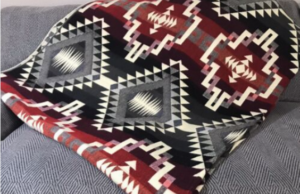Wool blankets are a popular choice for many people due to their warmth, comfort, and durability. However, for those with allergies, wool can often be a source of discomfort and irritation. It’s important for people with allergies to understand the potential risks associated with wool blankets and to consider their options before making a purchase.
One of the main concerns for people with wool allergies is the lanolin found in wool fibers. Lanolin is a natural oil that is found in sheep’s wool and is often used in skincare products. However, for people with allergies, lanolin can be a source of irritation, causing itching, redness, and rash. Some wool blankets may contain more lanolin than others, depending on the quality of the wool and the manufacturing process.
Another potential source of irritation for people with wool allergies is the dust and dirt that can accumulate in wool fibers. Over time, wool blankets can collect dust mites, pet dander, and other allergens, which can exacerbate allergy symptoms. Regular cleaning and maintenance can help to reduce the amount of allergens present in wool blankets, but for some people, even a well-maintained wool blanket may still cause discomfort.

For people with wool allergies, there are a few options to consider when it comes to choosing a blanket. One option is to choose a wool blanket that has been specifically treated to remove lanolin and other allergens. These blankets are often labeled as hypoallergenic and may be a good choice for people with mild to moderate allergies. However, it’s important to note that even hypoallergenic wool blankets may still contain small amounts of lanolin and other allergens, so it’s important to check the product label and do your research before making a purchase.
If you already own a wool blanket and are experiencing allergy symptoms, there are a few steps you can take to mitigate the effects. First, make sure to wash your blanket regularly, following the manufacturer’s instructions for care. This will help to remove any accumulated allergens and keep your blanket fresh and clean. You can also try using a vacuum cleaner with a HEPA filter to remove dust and other allergens from your blanket.
Wool blankets can be a source of comfort and warmth for many people, but for those with allergies, they can also be a source of discomfort and irritation. It’s important for people with allergies to understand the potential risks associated with wool blankets and to consider their options before making a purchase. Hypoallergenic wool blankets, alternative materials, and wool blends are all options to consider when choosing a blanket. Maintaining your wool blanket and taking steps to reduce allergens can also help to minimize symptoms. With careful consideration and proper care, wool blankets can be a great choice for people with or without allergies.
The psychology of wool blankets and comfort
Wool blankets are often associated with feelings of comfort, warmth, and safety. The psychology behind this association is rooted in our evolutionary history and the role that wool played in our ancestors’ lives.
One of the main reasons that wool is so comforting to us is its ability to regulate body temperature. Wool fibers are naturally insulating, meaning that they help to trap heat close to the body. This can be especially important during colder months or in drafty homes. The feeling of warmth and coziness that comes from being wrapped in a wool blanket can be incredibly soothing and comforting.
Another reason that wool blankets are so comforting is their texture. Wool fibers are naturally soft and fluffy, which can create a sense of tactile pleasure when we touch or snuggle into a wool blanket. This sensation can be especially soothing for people who have anxiety or who are feeling stressed.
The color and pattern of wool blankets can also play a role in our psychological response to them. Many wool blankets feature earthy tones or natural patterns, which can create a sense of connection to nature. This connection to nature can be grounding and calming, helping us to feel more centered and relaxed.
In conclusion, the psychology of wool blankets and comfort is complex and multifaceted. The physical sensations, aesthetics, and associations that come with wool blankets can create a sense of warmth, safety, and well-being. By understanding the psychological factors that contribute to our love of wool blankets, we can better appreciate their comforting properties and use them as a tool for self-care and relaxation.